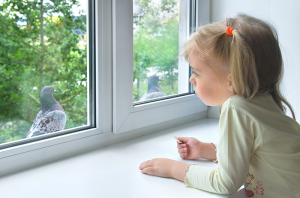 Flight is a magnificent means of transportation, but not without its dangers—especially for birds. For many birds, a journey across the skies ends with a deadly collision with windows, vehicles, cell towers or high-tension wires.
Flight is a magnificent means of transportation, but not without its dangers—especially for birds. For many birds, a journey across the skies ends with a deadly collision with windows, vehicles, cell towers or high-tension wires.
If you’ve been startled by the dull thud of a bird smacking your window, you’re not alone. Bird collisions with windows occur day and night, in all seasons, and in cities, suburbs and rural areas. Birds don’t see the glass, generally because it mirrors trees, shrubs, or sky, so the transparent panes appear to offer a passageway through a building.
It’s surprising how common this problem is. The National Fish and Wildlife Foundation and the U.S. Fish and Wildlife Service estimate that billions of birds die from aerial collisions each year in the U.S. And a lot of them, it seems, are colliding with our windows. Replacing glass or just cleaning it after a bird crash is a maintenance issue for the association.
Fortunately, some simple solutions can help protect our windows and the birds.
- Place birdfeeders either close to (within 3 feet) or far away from buildings (a minimum of 33 feet). Birds cannot build up enough momentum to injure themselves when flying to and from feeders that are very close to buildings. Conversely, when birds take flight quickly from feeders that are further from buildings, they are less likely to collide with windows.
- Hang a mobile, wind sock or strips of fabric on the outside of the window.
- Use an attractive window film, such as one that gives the appearance of glass etching or sandblasting to reduce reflections.
- Paint or stencil the window with soap or wax.
- Cover the window with garden protection netting or a screen.
- Hang multiple bird silhouettes on the outside of the window to break up the reflection.
- Replace standard windows with non-reflective glass, such as stained or frosted glass.




